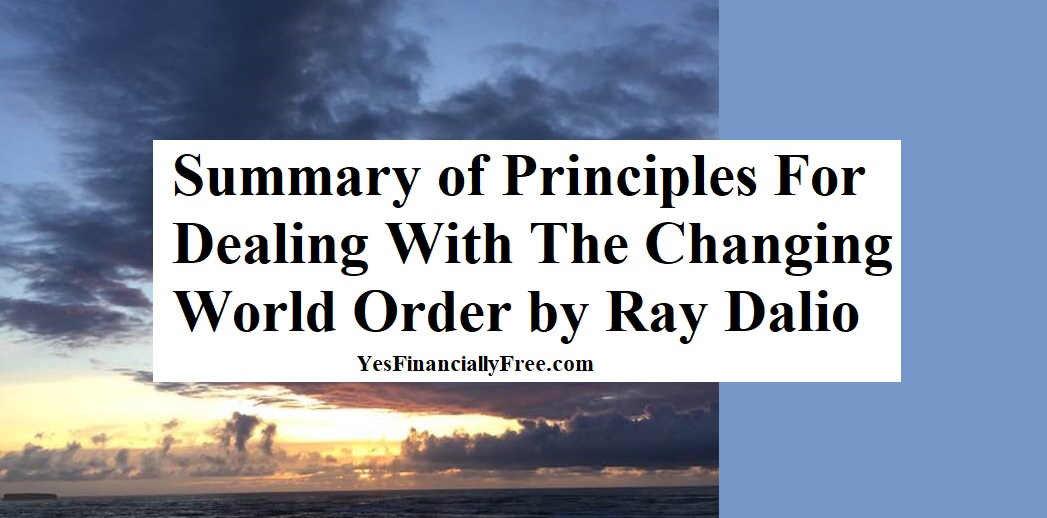
Summary of Principles For Dealing With The Changing World Order by Ray Dalio
Here is a Summary of Principles For Dealing With The Changing World Order by Ray Dalio, which popped up as an ad on a Youtube video by investor Marin Katusa.
First off, it is 43 minutes long, so you probably just want to watch it yourself!
World Orders Always Change in a Cycle
First, Ray Dalio basically says that the United States is an Empire on the decline and China is on the rise and will eventually become the new World Leader. He shows similar Empires from the past, the Dutch, British, and the United States, and the upcoming Empire which he believes to be China.
He uses charts of various world events and the valuations of their currencies and then simplifies these charts into these cycles of up and down. Empires rise and empires fall.
How to Measure a Country’s Health – Whether it is Rising or Falling
Ray Dalio basically says that there are 8 strengths a country has that can determine how strong it is in terms of staying at the top of the World Order. They are:
1) Education
2) Inventiveness
3) Competitiveness
4) Economic Output
5) Share of World Trade
6) Military Strength
7) Financial Center Power
8) Strength of Their Currency as a Reserve Currency
He says the stronger all these are, the more likely you will stay on the top of the World Order. The weaker they are, the more likely you are or soon no longer be on the top.
The Big Cycle
Ray Dalio says the change in World Order is a Big Cycle, and has these stages indicating the rise and fall of a world order.
1) War creates an order with one country becoming the leader – In World War II Allied Powers won the war, and the United States became the leader.
2) Peace and Prosperity and Productivity
3) Borrowing leads to a Financial Bubble
4) Currency Becomes a Reserve Currency
5) Wealth Gap
6) Financial Bust and Economic Downturn
7) Printing of Money and Credit
8) Revolution – Internal conflict occurs because of the Wealth Gap
9) Wars – an outside power becomes more powerful and takes over as world leader
He then details the Rise, the Top and the Decline of the Big Cycle.
The Rise
1) A Leader Rises That Gains Popularity and Consolidates Power
2) Education Creating Citizens Who are Inventive and Have Strong Character
3) The Citizens Are Productive and the Economy Grows
4) Pick their successors well, or create a system that does that
5) The country creates a Financial Center
6) The Government, Military and Business Sector Work Together
7) People start wanting their currency and they become the Preferred Reserve Currency
8) The Country can then Borrow more than any other country
9) This creates a financial bubble
The Top
1) Workers are more expensive in the leading power.
2) Other countries copy the leading country’s innovations, and build them with their own cheaper workers.
3) Workers in the leading power, become less productive.
4) Wealth Gaps grow and values change, inherited wealth makes wealthy people vulnerable, resentments grow between the rich and the ones who are not.
5) More Borrowing to Bet that the Good Times Will Last Forever, weakening the currency’s financial health, financing overconsumption and military
The Decline
1) Fighting Internally and/or Externally
2) The Country can’t pay off it’s debts, so it prints new money to pay off it’s debts, which devalues it’s currency, and causes inflation
3) When the living standards fall, then the Government tries to take the money from the Wealthy and redistribute it, which leads to the wealthy leaving. The Government will ban the wealth from leaving. Then there is either a peaceful or a violent redistribution of wealth, with the internal order of the country changing or staying the same.
4) External countries that are more wealthy start to challenge the empire, which may lead to wars, which will change the world order.
5) Other countries sell off that country’s money, and that marks the end of the cycle.
Health Indicators
He says you can tell how long a world power will last by checking these health indicators:
1) Leadership Capabilities
2) Education Levels
3) Character / Determination
4) Rule of Law
5) Corruption
6) Resource Allocation Efficiency
7) Openness to Global Thinking
Conclusion
I hope you enjoyed this Summary of Principles For Dealing With The Changing World Order by Ray Dalio. Ray Dalio says that it takes 10 to 20 years to transition from one World Order to a New World Order. He also says that the United States hasn’t reached the point of conflicts stepping over the line, and or other countries selling off the U.S. currency.
However, he wants to understand how to deal with this possible current decline of the United States as the country on the top of the World Order, and the rise of another great power – China.
His basic conclusion is the United States can improve it’s health by spending less than it makes (individually and as a nation), and by being kind to each other. He also recommends that we read his book –Principles For Dealing With The Changing World Order by Ray Dalio for more details.
Please comment and share!